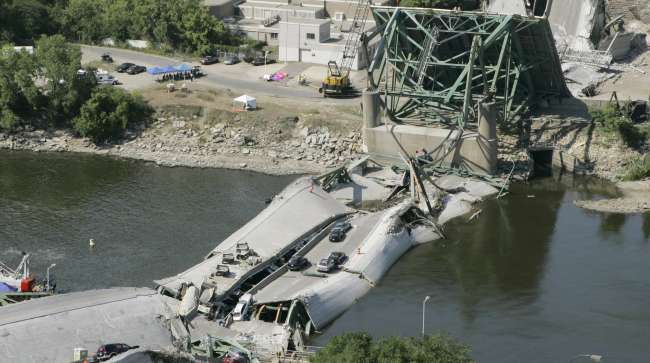Features Coordinator
10th Anniversary of Bridge Collapse Offers Glimpse at Infrastructure Repair

This month marks the 10th anniversary of a deadly bridge collapse in Minnesota, which shaped one of the earliest conversations about structurally deficient bridges and the significant funding needed to fix or replace infrastructure nationwide.
The Aug. 1, 2007, collapse of the Interstate 35 West bridge over the Mississippi River claimed the lives of 13 people and injured 145, according to the National Transportation Safety Board.
After the tragedy, a broad coalition of lawmakers, engineers, road builders, businesses and others took action.
“We went through and did inspections on all of our truss bridges over the next few months,” said Kevin Western, Minnesota Department of Transportation’s lead bridge engineer.
“The bridge was a catalyst for the Legislature to appropriate new money to address the bridge issues,” Minnesota Trucking Association CEO John Hausladen said.
“It is a day I will always remember and anyone involved in trucking in Minnesota will not forget,” he said, “when you saw trucks and you knew they were involved. That was one of our own.”
It wouldn’t be forgotten nationally either as bridge maintenance and inspections took center stage. More than 73,500 U.S. bridges were structurally deficient in 2007.
In October that year, Andy Herrmann, a board member of the American Society of Civil Engineers, testified before the U.S. Senate Environment and Public Works Committee in its hearing on the nation’s structurally deficient bridges.
“We wanted to bring [structurally deficient bridges] to their attention, and the committee wanted to find out more about them,” said Herrmann, who would later become president of the civil engineers. During the hearing, Herrmann touched on how to fix the issue: “Significant investment is essential to maintain the benefits and to assure the safety that society demands,” he said.
An investigation later uncovered that a faulty main gusset plate was to blame for the collapse.
The state’s bipartisan effort led to legislation for emergency funding to replace the I-35W bridge. Construction began by Nov. 1, 2007, and the new structure opened in 2008.
In the years since, the number of structurally deficient bridges has dropped to 55,710 in 2016 from 73,817 in 2007, according to the American Road and Transportation Builders Association.
“Just about every state has decreased their inventory of structurally deficient bridges and made some great strides,” said Alison Black, the group’s chief economist.
Oklahoma, California and Pennsylvania made the biggest strides in completing repairs to structurally deficient bridges since 2007, according to ARTBA.
While the number of deficient bridges has been on a steady decline, the average age of the nation’s bridges is worrisome. “Right now, the average bridge is 43 years old, and if you look at when those bridges were designed, they were designed for a life of 50 years,” Herrmann noted. “It is true that you can extend that life by repairing, modifying, inspecting, rehabilitating and maintaining, but you can also shorten its life by not doing those,” he said.
Since the 2007 collapse, bridge infrastructure investment nationwide has increased by $9 billion to $32.2 billion in 2016, according to the U.S. Census Bureau. For Herrmann, that is still not good enough. “We still are not investing enough in repairing or replacing those structurally deficient bridges,” he said.
ASCE’s 2017 Infrastructure Report Card graded the nation’s bridges a C+.
Today, Minnesota’s new I-35W bridge is outfitted with a “Smart Bridge System,” which includes sensors that constantly track stress. It is monitored by the University of Minnesota Twin Cities.
Western said MnDOT has been out to test the span more than once.
“We have put fully loaded plow trucks full of sand on the bridge, and those loads are not even a blip on the measurements for strains and stresses on the bridge” he said.
The bridge accommodates an average of 5,500 heavy trucks daily — part of the 160,000 vehicles daily, according to MnDOT.
“What really is the biggest load is the temperature change every year,” Western said, referring to the state’s subzero winters and hot summer months. Concrete contracts in extremely cold temperatures and expands during hot weather, making monitoring it crucial.
President Donald Trump has pledged to allot $1 trillion in infrastructure spending over the next 10 years.
Black said that federal funding will be critical. “Congress showing the political will to fix the Highway Trust Fund and increase federal investment would go a long way toward helping address these issues,” she said.
The Highway Trust Fund, which stems from federal fuel taxes, allocates money for infrastructure projects.
Hausladen added that more funding could come from an increase in the federal fuel tax, which has not changed since 1993. The federal tax on diesel is 24.4 cents per gallon and on gasoline, it’s 18.4 cents.
“You can’t build a bridge unless you have predictable funding,” he said.



